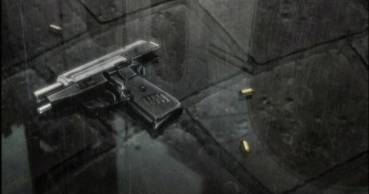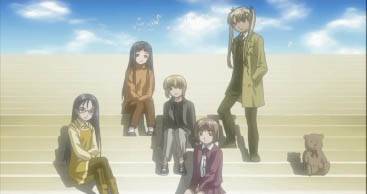"The
girl has a mechanical body.
However, she is still an adolescent
child." |
Gunslinger
Girl, released on Region 2 on 3rd March by MVM
Entertainment, is based on a popular manga by Yu Aida, and
tells the story of a shady government agency who – at least
on the surface – are in the business of saving the lives
of terminally ill young girls. The real purpose of this
generous and compassionate group, however, is to use cybernetic
implants and mental conditioning in order to turn these
girls into perfect killing machines, to be trained for stealth
infiltration and assassination missions – to do the government's
"dirty work".
Set
in contemporary Italy, the 13-episode series focuses on
the lives of four of these girls – Henrietta, Rico, Triela
and Claes – and their relationship with their male handlers,
who each form a unique bond with their chosen girl, and
are known in the business as fratello – siblings.
The handlers' methods of training are vastly dissimilar
– most choose, like the majority of the Agency staff, to
treat the girls as nothing more than tools to be used. But
Henrietta's handler, José, sees her as a living human
being and forms a close emotional bond with her.

The
five episodes contained in the first volume deal with themes
of emotional attachment and friendship between the girls
and their handlers, as well as asking the obvious question:
is saving these girls' lives worth destroying their innocence?
1:
Siblings
Henrietta fails a mission in order to protect José,
her handler. This leads the other Agency staff to think
that she needs further conditioning in order to eliminate
the attachment she feels towards him.
2:
Orion
José is worried by Henrietta's level of attachment
to him – she jumps at shadows and will kill anyone who makes
even the slightest move towards him. Just how deep does
this attachment go, and does José share it?
3:
Boy
Rico loves her new life at the Agency. For the first time
in her life, she can move freely, instead of being confined
to a hospital bed. But when Rico runs into an attractive
young man during a mission, she's forced to choose between
love, and her new life.
4:
Doll
Triela and her handler, Hillshire, have an awkward relationship.
She's not even sure whether he likes her or not. While chasing
an ex-Mafia boss in Naples, Triela begins to realise that
what she needs in her life is a father figure.
5:
Promise
The Agency make Captain Robollo an offer: train a new girl,
and they'll get him his old position in the Military Police.
He grudgingly accepts custody of Claes, but doesn't quite
know where he stands with her. At the Agency, he's all business,
but in their free time, he finds himself opening up to Claes
and feels guilty about what the girls are going through.
I was
first surprised by the level of gore used in the gunplay
missions. It's in harsh contrast to the non action-based
scenes, which use muted, pastel shades and greys to convey
a rather depressing world. Each gunshot seems to lead to
a mass of crimson blood. While I applaud the artists for
choosing to show the harsh reality of these kinds of wounds
– and granted, the gore isn't quite at Kill
Bill levels – it's jarring, even for viewers
used to this level of violence.

The
music, by Toshihiko Sahashi, is reminiscent of Yuki Kajiura's
score for .hack//SIGN, in that it uses
a European style befitting the show's Italian setting. There
are mournful piano and violin pieces, and slightly more
upbeat guitar tracks, to highlight the various moods that
each episode goes through. The opening theme is sung in
English, and the closing theme is an Italian opera piece
– both are uncommon in mainstream animé, with most
shows being content to throw a few English words into their
Japanese image songs. The sound effects – gunshots and footsteps
especially – are excellent, recorded in crystal clarity
and not confined to the background.
The
animation – produced by Madhouse Studios, the people behind
Chobits and Vampire Hunter D
– tends to be very detailed when it needs to be, but not
so much when it isn't as necessary. In particular, I noticed
that views from windows that aren't particularly focused
upon in the scene are usually not as detailed as perhaps
they could be. However, most backgrounds are excellently
realised. Characters are designed well – I especially liked
the way the girls' eyes are used to convey emotion.
All
in all, Gunslinger Girl focuses more upon
the emotional states and conflicts between the girls and
their male partners than the actual gunplay itself, which
is confined to short, intense bursts whenever the plot calls
for one of the girls to go on a mission. If you like constant
action sequences but don't care much for characterisation,
I can't say you'll enjoy this series – but when the girls
do get to fight, it handles it decently, and at times with
a kind of stylistic flair.
The
message of the series is ultimately one of caution. When
you look into these girls' lives – look deeply, beyond their
missions and the intense gunplay action – you can see how
hollow they've become. They're not allowed to do the things
that little girls do; they must instead train with guns
and assassinate politicians. Even their emotions are kept
in check by the brainwashing "conditioning" process
that they undergo. You find yourself starting to accept
that this is their way of life – even the way the missions
are carried out lulls the viewer into believing that this
is all perfectly normal. But then you stop to think – what
kind of monsters would do this to children? And how far
away is society from accepting this kind of practice?
Given
that the picture presents its fair share of challenges for
DVD – large areas of single colour, muted colour palette,
a deliberately overexposed look in places – the transfer
here is very good, with no obvious edge enhancement issues
or major artefact problems. The picture is framed 16:9 and
anamorphically enhanced.

The
disc comes with the original Japanese Dolby 2.0 stereo track
and a 5.1 English dub. It's a shame the Japanese track is
not also 5.1, as this is sonically superior, with better
separation and clarity, especially the music, which utilises
the rear speakers more than the dialogue or effects. That
said, as English dubs go this is a pretty good one, with
a clear attempt to match the voices to the Japanese original
and match them to the acoustics of the scene.
Optional
English subtitles are available.
As is
common with many animé DVDs, there are few special
features. The only one of note is Building Henrietta
(1:05), which shows the process of drawing Henrietta, step-by-step.
Aside from this, there's the usual clean opening and closing
credits, and trailers for Kiddy Grade and
Fullmetal Alchemist.
|